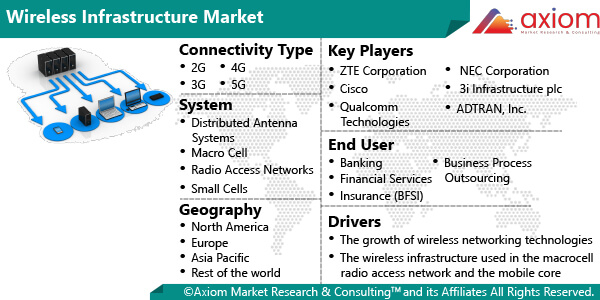Wireless infrastructure is a collection of different connectivity standards, communications and connectivity solutions that combine in operations to provide wireless networks to users. This network is more emphasized on improving overall connectivity and connection performance, while limiting the need for cable connections between different devices and components. Companies are focusing on the host and management of network and communications services as they address the problems of a high initial investment in unified communications. This led to the adoption of Cloud RAN, remote radio heads and other wireless infrastructure systems.
Wireless Infrastructure Market Dynamics
The growth of wireless networking technologies is a major driver of the growth of the wireless infrastructure market. The wireless infrastructure used in the macrocell radio access network and the mobile core is driving the growth of the wireless infrastructure market. Network growth and technological infrastructure growth in the industry requires high-speed connectivity and data transmission, which is expected to drive the growth of the wireless infrastructure market.
COVID 19 Impact on Wireless Infrastructure Market
Covid19 drastically affects the world supply chain and industrial sector growth. At the initial stages of the pandemic, the world experienced, ‘supply shocks’. COVID-19 has affected the production capacity and financial health of wireless infrastructure device providers. The pandemic has led to a widespread health crisis affecting the financial markets and economies of countries and end-users. This is expected to lead to an economic recession and negatively affect the short-term wireless infrastructure market.
Wireless Infrastructure Market Segmental Overview
The report analyses the wireless infrastructure market based on connectivity type, system, end use industry, and geography.
Wireless Infrastructure Market by Connectivity Type
By connectivity type, the global Wireless Infrastructure market is segmented into 2G, 3G, 4G, 5G, and satellite. Among these, the 5G segment is expected to be the fastest growing segment in the coming year. Next-generation technology with high speed, low latency and greater connectivity is expected to fuel the demand for 5G technology around the world.
Wireless Infrastructure Market by System
The global wireless infrastructure by system is classified into distributed antenna systems (DAS), macro cell, radio access networks (RAN), small cells, remote radio heads (RRH), cloud ran, carrier wi-fi, mobile core, and backhaul modules. Among these, macro cell segment holds the largest market share as it provides wider range of network area to the several connectivity such as 4G and 5G supporting devices.
Wireless Infrastructure Market by End Use Industry
The global wireless infrastructure by end use industry is classified into banking, financial services, and insurance (BFSI), business process outsourcing (BPO), telecom, automotive, government, healthcare, industrial, others.
Wireless Infrastructure Market by Geography
Geographically, the Wireless Infrastructure market is studied across the countries of key regions such as, North America, Europe, Asia Pacific and the rest of the world regions which includes Latin America, and Middle East & Africa. The Asia Pacific wireless infrastructure market is expected to grow in the forecast period. India is the one of the largest business process outsourcing (BPO) market that requires significant wireless infrastructure. In addition, the development and implementation of 5G technology has taken place in Asia: South Korea, Japan, Singapore and Taiwan were among the first countries to launch 5G services.
Wireless Infrastructure Key Players
Some of the major players operating in this market include ZTE Corporation, Cisco, Qualcomm Technologies, Inc. NEC Corporation, 3i Infrastructure plc, ADTRAN, Inc., Motorola Solutions, Inc, Telefonaktiebolaget LM Ericsson, SAMSUNG, FUJITSU, Juniper Networks, Inc., Vertical Bridge, LLC, COMMSCOPE, HUBER+SUHNER, Nokia, Huawei Technologies Co., Ltd., Corning Incorporated among others.











